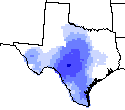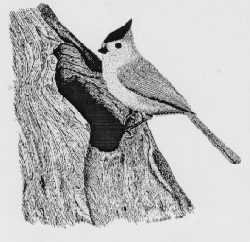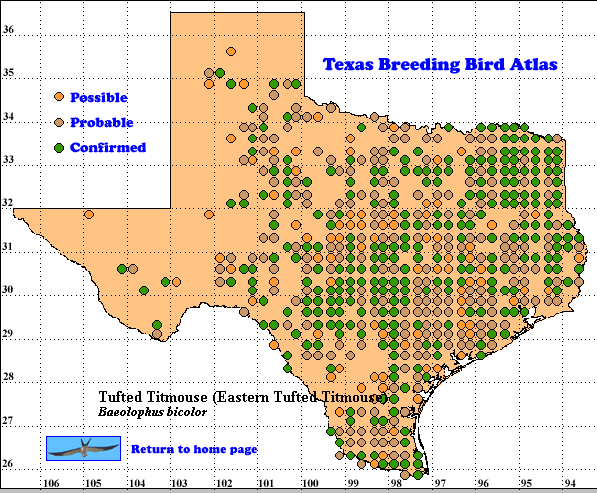Baeolophus atricristatus
Black-crested Titmouse, although considered a full species since its identification in 1850, was lumped with and then split from Tufted Titmouse (B. bicolor) during the taxonomic turmoil of recent years. Although differences between these two titmice have been identified through their genetics (see references in Patten and Smith-Patten (2008) and vocalizations (Coldren 1992) as well as plumages, these two species were not separated until 2002 (Banks et al 2002) because they hybridize in central Texas (Oberholser 1974).
Unfortunately field work for both the Texas and Oklahoma atlases was conducted during the period when these two taxa were lumped and they were not reported separately. Thus the species account on Tufted Titmouse (Coldren ca. 1993) covers Black-crested Titmouse as a subspecies of Tufted Titmouse. This account is intended to emphasis the recently re-recognized species and present material not available to Coldren. Both accounts should be consulted for a full picture of the breeding status of the Black-crested Titmouse in Texas.

North American Breeding Bird Survey map of the range of Black-crested Titmouse in the United States (Sauer et al. 2008).
DISTRIBUTION. During the 1987-1992 field work seasons of the TBBA project, atlasers found about 394 confirmed breeding records for both Tufted and Black-crested titmice. TBBA and North American Breeding Bird Survey (BBS) data (see maps below) indicate the latter species breeds primarily on the Edwards Plateau. The primary range continues on the Rolling Plains, South Texas Brush Country and Coastal Sand Plain regions. Black-crests also breed in appropriate habitats on mountain ranges in the Trans-Pecos (see the region map in Lockwood and Freeman [2004]). Apparent differences between the BBS and TBBA maps are probably due to the finer scale of the latter and gaps in project coverage (Coldren ca. 1993).
Analysis of the confirmed TBBA records for Black-crested and Tufted titmice provides evidence for an area of lower abundance of the two titmice between 96 and 97o W longitude. In this interval there were 33 confirmed sites, compared to an average of 66 for the two intervals to the east (94-96o) and 61 for the three intervals to the west (97-100o). This presumed primary overlap area is consistent with BBS data and that described by Coldren (ca. 1993), Lockwood and Freeman (2004) and Patten and Smith-Patten (2008). The maps in Oberholser (1974) also show almost all summer and breeding records for Black-crested Titmice west of 96o while most summer and breeding records of Tufted Titmice are east of 97o. The similarity of the BBS, TBBA and Oberholser maps also suggests the hybrid zone has not changed in recent years.
The range of Black-crested Titmice extends from Texas into extreme southwest Oklahoma (Stuart 2004) and northeast Mexico (Howell and Webb 1995, Am. Ornithol. Union 1998).
SEASONAL OCCURRENCE. Black-crested Titmice are year-round residents of their breeding range (Lockwood and Freeman 2004).. The breeding season lasts from late February to late July based on egg collection dates of completed clutches from March 11 to June 3 with dependent young still accompanying adults to at least mid-July (Patten and Smith-Patten 2008).
BREEDING HABITAT. In Texas Black- crested Titmice are found as high as about 230 m (750 ft; Oberholser 1974). Further south in Mexico these titmice are found as high as pine-oak woodland at 1000-3000 m (3300-10,000 ft; Howell and Webb 1995).
These cavity nesters usually use abandoned woodpecker holes in living trees, stumps, posts, utility poles and nest boxes. The cavity is lined with a variety of materials including animal hair, feathers, moss, lichens, rootlets, grass, leaves, bark strips, sticks, string, cotton, tissue paper, onion skin, and snake skin fragments. On this matting the female lays about 6 (range 4-7) smooth, white or pinkish-white eggs with small, reddish-brown speckles (Patten and Smith-Patten 2008).
Incubation lasts 12-14 days and probably is done by the female since the male lacks an incubation patch. The nestling period for the altricial young is unknown, but is probably similar to that of Tufted Titmice whose young leave the nest 15-18 days after hatching (Grubb and Pravasudov 1994, Patten and Smith-Patten 2008).
STATUS. Lockwood and Freeman (2004) consider Black-crested Titmice to be common residents in their range in Texas. BBS observers recorded an average of 10-30 Black-crests per 40 km (25 mi) route per year on much of the Edwards Plateau and some surrounding areas (see map at left). BBS data from 25 routes on the Edwards Plateau suggest the population there has been stable since 1980 (Sauer et al. 2008).
The data are encouraging for the future of Black-crested Titmice west of the Balcones Escarpment in Texas, although the uncertain effects of population growth on the Edwards Plateau and global climate change make any predictions of the future risky. Further study of this species in the mountain islands of the Trans-Pecos would better define its range.
Text by Robert C. Tweit (2009)
Literature cited.
American Ornithologists’ Union. 1998. Checklist of North American birds, 7th ed. Am, Ornithol. Union, Washington, DC.
Banks, R. C., C. Cicero, J. L. Dunn, A. W. Kratter, P. C. Rasmussen, J. V. Remsen, Jr., J. D. Rising, and D. F. Stotz. 2002. Forty-third supplement to the American Ornithologists’ Union Check-list of North American Birds Auk 119 :897-906.
Coldren, C. L. 1992. A comparison of the songs of the Tufted and Black-crested Titmice in Texas. M. Sc. thesis. Texas A&M University, College Station.
Coldren, C. L. ca. 1993. Tufted Titmouse (Baeolophus bicolor). In Texas breeding bird atlas (K. A. Arnold and K. L. P. Benson, eds.), Texas A&M University, College Station. <http://txtbba.tamu.edu/>
Grubb, Jr, T. C. and V. V. Pravasudov. 1994. Tufted Titmouse (Baeolophus bicolor), The Birds of North America Online (A. Poole, Ed.). Cornell Lab of Ornithology; Ithaca, NY. Retrieved from: http://bna.birds.cornell.edu/bna/species/086
Howell, S. N. G. and S. Webb. 1995. A guide to the birds of Mexico and northern Central America. Oxford University Press, New York.
Lockwood, M. W. and B. Freeman. 2004. The TOS handbook of Texas birds. Texas A&M University Press, College Station.
Oberholser, H. C. 1974. The bird life of Texas. University of Texas Press, Austin.
Patten, M. A. and B. D. Smith-Patten. 2008. Black-crested Titmouse (Baeolophus atricristatus), The Birds of North America Online (A. Poole, Ed.). Cornell Lab of Ornithology; Ithaca, NY: Retrieved from: http://bna.birds.cornell.edu/bna/species/717
Sauer, J. R., J. E. Hines, and J. Fallon. 2008. The North American breeding bird survey, results and analysis 1966-2007. Version 5.15.2008. USGS Patuxent Wildlife Research Center, Laurel MD < http://www.mbr-pwrc.usgs.gov/bbs>
Stuart, R. A. 2004. Tufted Titmouse (Baeolophus bicolor) – Black-crested Titmouse (Baeolophus atricristatus). In Oklahoma breeding bird atlas, pp. 300-301 (D. L. Reinking, ed.). University of Oklahoma Press, Norman.

